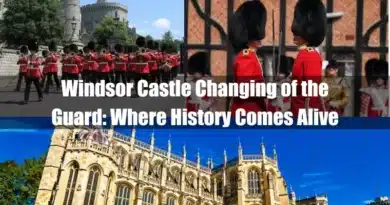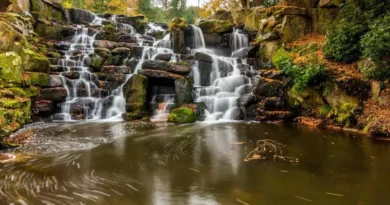The Windsor Castle fire was a devastating fire that broke out at Windsor Castle, the world’s oldest and largest occupied castle, on November 20, 1992. The fire started in the Queen Victoria’s Private Chapel and quickly spread to the State Apartments, causing extensive damage. The fire was finally extinguished after 15 hours, but over 115 rooms had been destroyed.
I. When and where did the fire occur?

The Windsor Castle fire occurred on November 20, 1992, at Windsor Castle, Berkshire, England. The fire started in the Queen’s Private Chapel, the northeast corner of the Upper Ward of Windsor Castle. The chapel was a small, private chapel that the royal family used for worship. The fire started around 11:30 a.m. on November 20, 1992, quickly spreading to the adjacent State Apartments.
The cause of the Windsor Castle fire in 1992 was a faulty spotlight that ignited a curtain in Queen Victoria’s Private Chapel. This is confirmed by the Royal Collection Trust, which manages the castle’s collections and public opening.
A. Details
- Fire Starts: The fire started in Queen Victoria’s Private Chapel around 11:30 a.m.
- Initial Response: Royal Household agents were inspecting works of art at the time. The Castle Fire Brigade watch room detected the fire and showed the location on the grid map.
- Spread of the Fire: The fire spread quickly to neighbouring rooms, including Brunswick Tower. Building contractors attempted to extinguish the fire with fire extinguishers, but the 30-foot-long curtains ignited and continued to burn.
- Alarm and Evacuation: The castle activated the public fire alarm and telephoned the Royal Berkshire Fire and Rescue Service. Castle’s fire brigade arrived shortly after, equipped with Land Rover and pump tender.
- Firefighting Efforts: Over 200 firefighters came from London, Buckinghamshire, Surrey, Oxfordshire, and Berkshire. At the peak of the operation, 225 firefighters were involved, using 1.5 million gallons of water from various sources, including the mains water supply, reservoir-fed hydrant, swimming pool, pond, and the nearby River Thames.
- Major Damage: The fire caused significant damage to St George’s Hall and other State Apartments. The roof of St George’s Hall collapsed at around 7:00 p.m.
- Control and Extinguishing: After burning for nine hours, the fire was under control by 8:00 p.m. but continued to burn for another three hours. The main fire was extinguished at 11:00 p.m., and the last secondary fires were extinguished at 2:30 a.m. on November 21.
- Aftermath: For many more days, sixty firefighters and eight appliances were on duty to manage the remaining hotspots.
The fire spread quickly because of the enormous cracks and gaps in the roof, contributing to the extensive damage.
II. The Aftermath of the Windsor Castle Fire

Employee and Tradesmen Response
After the fire, employees and tradesmen worked alongside the castle’s salvage corps and fire department to remove furnishings and artwork from endangered areas. This included moving a 150-foot-long table and a 120-foot-long carpet from the Waterloo Chamber to the safety of the castle’s riding school.
Three hundred clocks, a collection of miniatures, thousands of valuable books, historical manuscripts, and Old Master drawings from the Royal Library were also saved. Heavy chests and tables were left behind on fire officers’ instructions. At the same time, other items were placed on tarpaulin sheets in the North Terrace and Quadrangle.
The police called in removal vans from various counties to transport items to other parts of the castle. Key members of the Royal Household, including the 13th Earl of Airlie and other staff, actively participated in the operation.
Royal Collection Department and Household Cavalry
The Royal Collection Department played a crucial role, with Sir Geoffrey de Bellaigue as director, Christopher Lloyd as picture surveyor, Jane Roberts as curator of the Print Room, Hugh Roberts as deputy surveyor of the Queen’s art, and Oliver Everett as librarian. The Household Cavalry, arriving from nearby Combermere Barracks, along with 100 officers and men of the Life Guards, were invaluable in moving bulky items.
The scale of the Recovery Effort
The recovery effort involved 125 castle employees, 125 contractors, 100 military personnel, and 20 Crown Estate employees. Despite the intensity of the fire, there were no serious injuries or deaths. Dean Lansdale, a decorator in the Private Chapel, sustained burns while rescuing pictures and was hospitalized. Media reports of a heart attack suffered by the Queen’s picture surveyor were denied by a royal spokesperson. Five firefighters were hospitalized with minor injuries.
III. Windsor Castle Fire Damages

A. Structural damage to Windsor Castle in the 1992 fire
The fire caused the most damage to the fabric of the castle.
The fire at Windsor Castle spread rapidly due to the false ceiling in St George’s Hall and the space for coal trucks beneath the floor. This allowed the fire to spread to the Chester Tower and caused the ceilings of several rooms to collapse, including the Crimson Drawing Room, Green Drawing Room, and Queen’s Private Chapel. St George’s Hall survived, but the ceiling collapsed. The State Dining Room and Grand Reception Room were also severely damaged.
A total of 100 rooms were affected by the fire, including the Star Chamber, Octagon Room, Brunswick Tower, Cornwall Tower, Prince of Wales Tower, Chester Tower, Holbein Room, and Great Kitchen. The heat also severely damaged the external wall above the bay window of the Crimson Drawing Room.
B. Items Lost in the Windsor Castle Fire
The most damaged rooms had been emptied of their valuables. Still, some items were lost, including a large painting by Beechey, a sideboard, porcelain, chandeliers, the organ, and part of the Great Exhibition carpet. The Secretary of State called the fire a national disaster.
C. Complete Detail
Here is the complete information on the damages to Windsor Castle in 1992 due to the fire:
- The primary damage occurred to the structural integrity of the castle.
- The false ceiling in St George’s Hall and the void for coal trucks beneath the floor allowed the fire to spread.
- The fire burned as far as the Chester Tower.
- Several ceilings collapsed.
- The Crimson Drawing Room was completely gutted in the fire.
- The Green Drawing Room, while badly damaged, was only partially destroyed by smoke and water.
- The Queen’s Private Chapel suffered damage, which included the double-sided 19th-century Henry Willis organ in the gallery between St George’s Hall and the Private Chapel, as well as damage to the oak panelling, glass, and the altar.
- St George’s Hall, while mostly preserving its walls, experienced a collapsed ceiling.
- The State Dining Room within the Prince of Wales Tower and the Grand Reception Room suffered severe devastation.
- The fire affected a total of 100 rooms within the castle.
- Among the smaller apartments, the Star Chamber, Octagon Room, Cornwall Tower, Prince of Wales Tower, Brunswick Tower (buried under 12 feet of debris), Chester Tower, and Great Kitchen faced damage, with the latter losing its plaster coving and a significant portion of its medieval timber, and the Holbein Room.
- The external wall above the bay window of the Crimson Drawing Room, positioned between the Prince of Wales and Chester Towers, exhibited severe calcification.
- A substantial painting, a smaller rendition of George III and the Prince of Wales Reviewing Troops by William Beechey, was lost in the fire.
- The day before the fire, valuables in the most severely affected rooms had been removed, and some paintings were on loan for a travelling exhibition.
- Items from the Royal Collection that were lost included the equestrian portrait of George III and the Prince of Wales Reviewing Troops by Sir William Beechey, a large painting measuring 13 feet by 16 feet, which was too large to rescue. Additionally, an 18-foot-long sideboard from the 1820s crafted by Morel and Seddon, various pieces of porcelain, chandeliers, the 1851 Great Exhibition Axminster carpet, and the Willis organ suffered damage, with the carpet being partially burnt.
- Peter Brooke, who was Secretary of State for National Heritage at the time, described the fire as a national disaster.
- Tourists were granted access to the castle precincts within three days of the fire.
- The Queen returned to reside in the castle two weeks after the incident.
- The Gallery and Queen Mary’s Dolls’ House were reopened in December.
- After rewiring was completed, the State Apartments reopened in 1993. By Easter, all major rooms were open; only St George’s Hall and the Grand Reception Room remained closed.
- Consequently, eleven out of the fifteen primary chambers within the State Apartments were accessible to the public, while two were in extensive restoration, and two others had suffered complete destruction.
IV. From the Ashes: The Restoration of Windsor Castle

A. The Funding of the Windsor Castle Restoration Project
The initial projection for the castle’s restoration stood at £60 million, yet the final expenditure amounted to £36.5 million (equivalent to £62 million in 2019). The anticipation was that a decade would be required to desiccate the castle. Royal palaces under occupation, such as Windsor Castle, hold too much value to be subject to insurance, and assets within the Royal Collection lack coverage against loss.
On February 16, 1993, Coutts, the Bank of the Queen, declared the establishment of an autonomous trust aimed at receiving private contributions for the refurbishment expenses. By April 29, 1993, it was proclaimed that 70% of the expenses would be covered by charging the general public for access to the castle’s premises, with an £8 fee for admission to Buckingham Palace over the ensuing five years.
The Queen made a personal contribution of £2 million. She consented to commence paying income taxes from 1993 onward, marking her as the initial British monarch to do so since the 1930s.
B. Rebuilding Windsor Castle: A Vision for the Future
The details regarding the renovation project were disclosed on June 7, 1994. The Royal Household assigned the architectural company Donald Insall Associates to assume overall responsibility for the restoration. Simultaneously, Sidell Gibson took charge of the reconstruction of St George’s Hall, Private Chapel, and the design of the new Lantern Lobby.
More than half of the rooms that had suffered damage or destruction, such as the State and Octagon dining rooms, were slated for restoration to their original state. The St George’s Hall ceiling, incorporating steel reinforcing beams in the roof, the East Screen, the Queen’s Private Chapel, and the Stuart and Holbein Rooms were all scheduled for new designs. However, only the Queen’s Private Chapel and several contemporary rooms were set to be renovated in a modern style.
Proposals were presented to a Restoration Committee chaired by Prince Philip, the Duke of Edinburgh, and Charles, the Prince of Wales, deputy chairman. Committee members encompassed individuals like Sir Hayden Phillips (Permanent Secretary of the Department of National Heritage), David Ogilvy, the 13th Earl of Airlie (Lord Chamberlain), Norman St John-Stevas, Frank Duffy (President of the Royal Institute of British Architects), Sir Jocelyn Stevens (Chairman of English Heritage), Lord St John of Fawsley (Chairman of the Royal Fine Art Commission), and three high-ranking palace officials.
C. A New Chapter in Windsor Castle’s Historic Story
The devastating fire, while a calamity, provided a chance for significant fresh architectural endeavours. The architects believed that, given the historical background of the structure and the surviving materials, the new undertaking needed to embrace a Gothic style. Nonetheless, some critics found fault with it for its lack of creativity.
Refurbishing the gilded sideboard in the State Dining Room proved to be among the most demanding tasks. This piece of furniture, measuring 19 feet in length and crafted from the rarest rosewood and oak, needed to be reproduced by N.E.J. Stevenson, a Rugby-based artisan, relying solely on a set of photographs and descriptions.
On January 24, 1995, the Queen endorsed the fresh blueprints for St George’s Hall and the Queen’s Private Chapel. Conceived by architect Giles Downes, the novel roof adorning St George’s Hall exemplifies a hammer-beam ceiling. The newly positioned chapel and connected cloisters were reconfigured to create a ceremonial pathway from the private quarters through an octagonal foyer leading into St George’s Hall.
Downes’s innovative roof is the most substantial green-oak construction since the Middle Ages. It features vibrant shields celebrating the heraldic aspects of the Order of the Garter. The design imparts the illusion of increased elevation through the Gothic carpentry along the ceiling. Observers have remarked that Downes’s efforts substantially compensate for the initially erroneous dimensions of the hall.
The Lantern Lobby boasts oak columns that shape a vaulted ceiling, artfully resembling an arum lily.
The inaugural phase of the structural revitalisation was finalised by May 1996. The interior furnishing, originally scheduled for completion by the spring of 1998, was concluded on November 17, 1997. Her Majesty, the Queen, hosted a gathering in the recently rejuvenated hall in honour of the architects and construction professionals who were instrumental in this endeavour.
Laser scanning, digital photography, computer-aided design (CAD), drone technology, and heritage management software were used to restore Windsor Castle. These technologies allowed the restoration team to work more efficiently and achieve a higher work standard. They also helped raise public awareness of the restoration project and generate support for the work.
V. The Legacy of the Windsor Castle Fire

The Windsor Castle fire was a significant event that sparked national conversations about Britain’s heritage and identity. Some viewed the fire as a symbolic reminder of the decline of the British Empire, a complex historical debate. Others questioned the future of the monarchy, though public opinion polls at the time indicated continued support for the Royal Family.
The Windsor Castle fire also significantly impacted the field of fire safety. The fire highlighted the importance of fire safety in historic buildings. Since the fire, several new fire safety measures have been implemented at Windsor Castle and other historic buildings throughout the United Kingdom.
The Windsor Castle fire was a devastating event. Still, it also served as a powerful reminder of the importance of British heritage and culture. The castle is a national treasure, and the restoration project ensured that it would be preserved for future generations.
VI. The Role of Queen Elizabeth in the Rebuilding of Windsor Castle

A. The Role of Queen Elizabeth
Queen Elizabeth played a significant role in rebuilding Windsor Castle after the devastating fire in 1992. The fire deeply affected her, as Windsor Castle was a place of great personal and historical significance.
Elizabeth oversaw the overall restoration project. While she approved the general restoration plans, the detailed decisions about the design and layout of the rooms were made by the Restoration Committee chaired by the Duke of Edinburgh.
Elizabeth was actively involved in fundraising for the rebuilding project. She launched a public appeal for donations and contributed her own funds. The total cost of the restoration was £36.5 million, funded through private donations and the opening of Buckingham Palace to the public.
Elizabeth regularly visited the castle during the rebuilding project to inspect the work and meet with the workers.
Windsor Castle was rebuilt in five years, and Queen Elizabeth II officially reopened the castle on November 20, 1997.
B. Examples of Queen Elizabeth’s Involvement in the Rebuilding of Windsor Castle
- Approval of Plans: She approved the plans for the new State Apartments, designed by the architect Donald Insall.
- Fundraising: She launched a public appeal for donations and donated a significant sum. She encouraged her friends and family to donate to the appeal and received donations from members of the public worldwide.
- Site Visits: She regularly visited the castle during the rebuilding project, inspecting the work and meeting with the workers.
- Selection of Artworks: She was involved in selecting the works of art that would be displayed in the castle, including paintings, sculptures, and furniture.
- Public Engagement: Her regular visits to the site and public pronouncements inspired the British people during the restoration process.
VII. The Impact of the Windsor Castle Fire on British Society

The Windsor Castle fire of 1992 had a profound impact on British society. The fire was a major news story worldwide, and it sparked a renewed interest in British history and culture. It also led to a debate about the cost of maintaining the Royal Family and the monarchy’s role in modern Britain.
The fire also significantly impacted the British economy. The estimated cost of rebuilding the castle was approximately £36.5 million (around £62 million in 2019), not £350 million as previously thought. This was a substantial sum at a time when the British economy was facing challenges.
The fire affected tourism, but tourists were allowed back into the precincts within days, and the full restoration was completed by 1997.
Despite these negative impacts, the Windsor Castle fire also had some positive effects. It led to a renewed sense of national pride and unity as the British people rallied around the Royal Family and contributed generously to the rebuilding effort.
The fire also prompted improvements in fire safety at historic buildings throughout the United Kingdom. New fire safety regulations and systems were implemented during the restoration process.
Overall, the Windsor Castle fire had a significant impact on British society, influencing debates about the monarchy and the cost of maintaining historic buildings and leading to advances in fire safety measures.
Examples of the Impact of the Windsor Castle Fire on British Society:
- Debate on the Monarchy: The fire sparked discussions about the cost of maintaining the Royal Family and the monarchy’s relevance in modern Britain.
- Economic Impact: The cost of rebuilding the castle was approximately £36.5 million. This was significant at a time when the British economy was struggling.
- Tourism: The number of visitors to Windsor Castle initially fell after the fire, affecting local businesses that relied on tourism.
- National Pride and Unity: Despite the negative impacts, the fire renewed
- Improvements in Fire Safety: The fire led to several improvements at historic buildings throughout the United Kingdom. New fire safety regulations were introduced, and many historic buildings were fitted with modern fire detection and suppression systems.
The Windsor Castle fire remains a significant event in British history, studied for its impact on society and the subsequent improvements in heritage conservation and fire safety.
VIII. The Windsor Castle Fire Today
The Windsor Castle fire today is a reminder of the fragility of British heritage and the importance of preserving historic buildings. It is also a reminder of the British people’s resilience and commitment to their traditions.
The castle has been fully restored and is now one of the most popular tourist attractions in the United Kingdom. It is also a working royal palace, and the Queen and other royal family members use it for official and private engagements.
The Windsor Castle fire is a significant event in British history and continues to be remembered and studied today. It is a cultural phenomenon that has had a lasting impact on British society.
IX. Citations
- The History Press | The Windsor Castle fire: 25 facts. (n.d.). https://www.thehistorypress.co.uk/articles/the-windsor-castle-fire-25-facts/
- 1992 Windsor Castle fire. (2023, September 22). Wikipedia. https://en.wikipedia.org/wiki/1992_Windsor_Castle_fire
- 27 Years Ago Today; Windsor Castle fire devastates historic residence – Democratic Underground. (n.d.). https://www.democraticunderground.com/100212707998










Comments are closed.